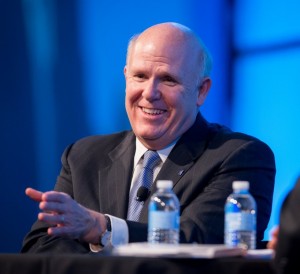In a complicated business in a complicated world, Dan Akerson took over as General Motors chairman and chief executive officer after attending exactly seven meetings of GM’s reconstituted board of directors.
But little more than a year after emerging from its 2009 bankruptcy, the automaker was about to face another crisis: its short-time Chairman and CEO Ed Whitacre decided he didn’t want to work that hard and resigned – just before GM was set to pitch the largest IPO in corporate history. It wasn’t quite a case of drawing straws, but Akerson was clearly surprised to be offered the job – and unsure of how his family might react.
“After 40 years of marriage, it wasn’t something you discuss over the phone,” noted Akerson, who flew home to Northern Virginia with some trepidation to explain his decision to his wife, the one-time Navy officer revealed during an unscripted and revealing 50-minute discussion of his time at GM during the annual Automotive News World Congress.

Mary Barra was picked by former CEO Dan Akerson to lead General Motors. She's the first woman to helm the company.
At the time the new board of directors was in an uproar. “We were having a crisis,” said Akerson, who recounted that the GM’s directors had just approved an S1, a detailed legal document that needs to be filed with the Securities & Exchange Commission for the IPO.
The “new” GM’s initial stock offering was intended to accelerate its recovery from the government-supervised bankruptcy the previous year. But Whitacre, the tall Texan, who had taken on running GM during the bankruptcy, was tired of the job and wanted to leave. Investor confidence critical to the IPO required stable leadership, noted Akerson, who had been through several other stock offerings during his days in private equity with the giant Carlyle Group. He also had been a chief executive officer of two different telecom companies.
“I was asked to leave the room and when I came back, I was told I had been elected chairman,” recounted Akerson, who was also named the company’s CEO.
For Akerson, it wasn’t the realization of boyhood quest or a dream. But it was a call to duty for a graduate of the U.S. Naval Academy at Annapolis.
Akerson agreed to serve on GM’s board after getting a call from the U.S Treasury Department in the summer of 2009, he recalled, shortly after cleaning out the impressive outsized office on the 38th floor of the General Motors headquarters in Detroit’s Renaissance Center.
“I agreed with the bailout,” said Akerson, who noted his view was sustained by two U.S. Presidents with radically different political perspectives.
“This was a mission. You had to believe you were doing this for the good of the company, this region of the country and for the United States,” he added. “This industry is about 4-plus percent of the GDP, and General Motors is a big part of that in this country,” Akerson said.
Akerson said, even though he was virtually unknown to the company’s senior management and thousands of employees and had attended only a handful of board meetings, he had come to believe that GM had “good bones.” but needed some positive direction and coaching.
“I was quite enthusiastic about the company and the position it had. It was part of what I grew up with,” added Akerson, who said his father was a “Sloan man” who, over the years, moved up the GM brand ladder, buying cars from Chevrolet then Pontiac then Buick.
“I thought it was an honor to be asked,” Akerson added, though it did require some painful personal sacrifice on his part since his wife’s mother became gravely ill and died during his tenure at CEO. But it was another family crisis that led him, late in 2013, to announce his departure from GM months ahead of the original schedule, his wife diagnosed with advanced cancer.
What that would trigger was equally unexpected. Akerson convinced the GM board to name Mary Barra, a 34-year veteran and head of the maker’s global product development operations, his successor.
“We bought a place here (in Detroit) and I did want to become part of the community,” said Akerson almost wistfully, suggesting he felt part of his work was still unfinished despite a number of generous bequests to organization of charities in the Detroit area, including one for $1 million dollars to local chapter of Habitat for Humanity.
Akerson, however, also stressed he believed he had a positive impact on the company and its employees. “The GM employee base was very committed. They were embarrassed by what happened,” he said. But morale was “fragile” and the company’s prospects looked grim.
“We had allowed ourselves to be eclipsed by the competition,” he said, stressing that GM’s problems had been building since the 1960 and 1970s. There was the massive unfunded pension liability issue, but Akerson also was shocked to find out it took GM eight weeks to close its financial books and the company’s auditors still found they were studded with deficiencies.
“That had to be revamped,” he said. “We didn’t even know the profitability of different vehicle lines. We do now,” he said.
But the effort required to set the change in motions was enormous, he said. After taking over as chairman and chief executive officer, he spent a year working 12 to 16 hours a day, addressing GM’s issues and finding solutions to what he considered major problems.
“We didn’t even have control over our own IT,” he said. So he ordered that the management of information technology functions be brought back in-house.
(Old problems still likely to dog new GM chief, Mary Barra. For more, Click Here.)
Akerson also elevated a new generation of GM managers. He initially put Mary Barra in charge of human resources. “I can hear some people in the audience groan but you usually don’t put your franchise player in human resources,” said Akerson, who often uses sports metaphors as he discusses management philosophy. In 2012, Barra was moved over to what may be called the heart of the company, product development.
“It was chaotic,” he recalled. The notion of accountability had frayed and parts of the organization had too much freedom.
Nevertheless, Akerson found the talent he felt the maker needed in Barra, Mark Reuss and Dan Ammann. Reuss was a GM veteran whose father had once been the maker’s president. Ammann was initially hired away from Morgan Stanley to serve as treasurer and help put together the GM IPO. This week he became the maker’s new President.
(Click Here to see why GM is forecasting a rise in profits.)
“There was a generation of management that rose to the occasion. We couldn’t go out and pay big money to get a big time management team. But I don’t think money was an issue,” Akerson said, recalling that the company was “very fragile,” uncertain of its direction and its ability to achieve a turnaround.
Akerson said that Barra had all the attributes one might want in a CEO. “She’s humble, she smart, she’s a good leader.”
And she’s not one to adopt the “larger-than-life” management style that had been so common in Detroit management. That approach “created some anomalies,” according to Akerson, who preferred riding up in the elevator with other employees rather than used the one reserved for the CEO. “We had 38,000 square feet (of management space) for four people. If someone was traveling, it was like a morgue” he said. “My bathroom (at GM headquarters) was larger than some offices I had” in previous jobs.
In the end Akerson indicated he was satisfied his tenure at GM was successful – even if there’s yet unfinished business. “We’re very close to the projections we had four years ago,” when GM set out to sell the IPO to investors around the world. “The onus was on our back to deliver results.”
GM has delivered with 15 consecutive profitable quarters; it has regained an investment-grade credit rating, returned to the Standard & Poor’s 500 Index and this week announced it would pay a dividend to shareholders for the first time since 2008.
“We had to create a vision and we had to underpin it” with success, he said. “I tried to lead by example. Team trumps talent.”
Later asked by TheDetroitBureau.com what he thinks his legacy might be, Akerson said, “I want to be able to look at this company in 2020 or 2030, when I’m really old, and know I was part of that (turnaround), then fade to black.”

